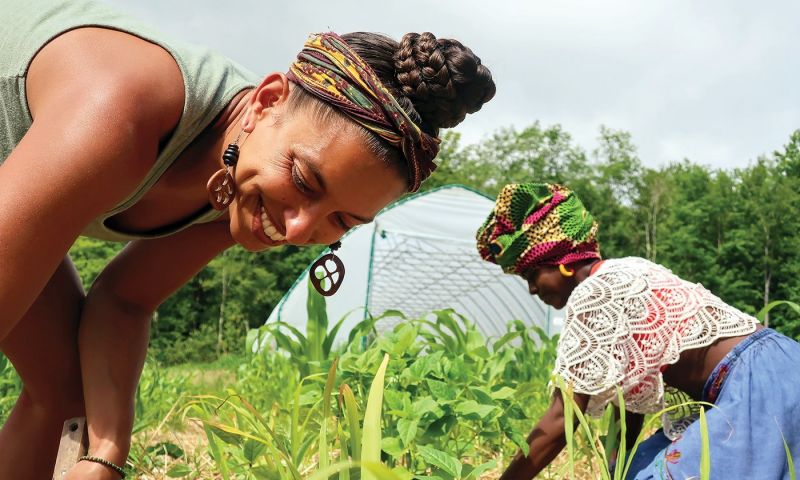The Gift of Ecological Humility
 In my early 20s, I apprenticed myself to the The Queen Mothers of Kroboland in Ghana with the hope of understanding more about my cultural heritage. Early one morning, I arrived at the compound of Paramount Queen Mother Manye Nartike, who was particularly animated by a rumor she had heard about our diasporic practices in relation to land. In disbelief she admonished me, “Is it true that in the United States, a farmer will put the seed into the ground and not pour any libations, offer any prayers, sing, or dance, and expect that seed to grow?” Met with my ashamed silence, she continued, “That is why you are all sick! Because you see the Earth as a thing and not a being.”
In my early 20s, I apprenticed myself to the The Queen Mothers of Kroboland in Ghana with the hope of understanding more about my cultural heritage. Early one morning, I arrived at the compound of Paramount Queen Mother Manye Nartike, who was particularly animated by a rumor she had heard about our diasporic practices in relation to land. In disbelief she admonished me, “Is it true that in the United States, a farmer will put the seed into the ground and not pour any libations, offer any prayers, sing, or dance, and expect that seed to grow?” Met with my ashamed silence, she continued, “That is why you are all sick! Because you see the Earth as a thing and not a being.”
She was right, of course. As African Americans, our 400-plus years of immersion in racial capitalism—the commodification of our people and the planet for economic gain—has attempted to crush our sacred connection to the Earth. Many of us have forgotten that our cultural heritage as Black people includes ecological humility, the idea that humans are kin to, not masters of, nature.
Despite the pressures to assimilate, there are those who persist in believing that the land and waters are family members, cling to our ancestral ways of knowing, and continue to practice Earth-based technologies. Among the myriad Afro-Indigenous practices that can assist all of humanity on our journey to an ecological civilization, three are explored herein: Ifa divination, soil stewardship, and cultural biomimicry.
Ifa Divination
A salient example of ecological humility, and a powerful challenge to human supremacy in Black ecological thought, is the system of Ifa divination. Practiced among Yoruba communities and throughout the African diaspora, the Ifa divination system was inscribed in the Intangible Cultural Heritage of Humanity list by the United Nations Educational, Scientific, and Cultural Organization in 2008.

Awo Onigbonna casts Ifa, a divination practice that Soul Fire Farm uses to ask permission of the Land before cutting down a tree, digging a foundation, or altering an ecosystem. If such a practice of pause and consent were universal, nature would have the opportunity to say, “Enough!” and be heeded. Photo by Enroue Halfkenny.
During divination, a highly trained priest of Ifa uses consecrated palm nuts and a divining chain to reveal verses of sacred literature that guide people in making decisions in alignment with their destiny and in harmony with natural laws. In contrast to the materialism and individualism of the West, this Indigenous practice requires that we ask permission of the Forces of Nature (Orisas) before any major undertaking. Further, this tradition views nature as divine. As explained by Professor Wande Abimbola, the Awise Awo ni Agbaye (World Spokesperson for Ifa), in his book Ifa Will Mend Our Broken World, “All the rivers of Yorubaland are divinities. All of the hills and mountains are divinities, and they are worshipped by the people. The Earth itself is sacred! As a matter of fact, the Earth is a divinity.”
One does not fill a wetland that is also a divinity. One does not level a forest that is venerated. As with most Indigenous practices, Ifa divination has been under attack since the beginning of Western colonization by missionaries and faith leaders in Christianity and Islam. Our resistance to this spiritual erasure will be fundamental to our protection of the natural world.
At Soul Fire Farm, we use Ifa divination to ask permission of the Land before cutting down a tree, digging a foundation, or altering an ecosystem. If such a practice of pause and consent were universal, nature would have the opportunity to say, “Enough!” and be heeded.
Soil Stewardship
Black ecological thought also offers us a powerful soil ethic and a charge that each of us protect and augment. We depend upon this “black gold” for survival. Over the past 700-plus years, women in Ghana and Liberia have combined several types of waste—including ash and char from cooking, bones from meal preparation, by-products from processing handmade soaps, and harvest chaff—to create African Dark Earths. According to a 2016 study in Frontiers in Ecology and the Environment, this compost has high concentrations of calcium and phosphorus, as well as 200-300% more organic carbon than soils typical to the region.
Today, community elders measure the age of their towns by the depth of the black soil, since every farmer in every generation added to its creation. As I previously wrote in my article “Reconnecting with Soil, We Heal the Planet and Ourselves,” the Ovambo farmers of Namibia and Angola also originated a high-fertility system of nurturing “their soil over generations through mounding, ridging, and the application of manure, ashes, termite earth, cattle urine, and muck from wetlands.” The friable, nutrient-dense raised beds of modern organic agriculture are rooted in Ovambo agrarian technology.
Dr. George Washington Carver carried on this legacy in the diaspora. I’m intentional about noting in my articles and speeches that Carver “was one of the first agricultural scientists in the United States to advocate for the use of leguminous cover crops, nutrient-rich mulching, and diversified horticulture. He advised early 20th-century farmers to dedicate every spare moment to raking leaves, gathering rich earth from the woods, piling up muck from swamps, and hauling it to the land. Carver believed that ‘unkindness to anything means an injustice done to that thing,’ a conviction that extended to both people and soil.”
Today, Black farmers continue to take a leadership role in regenerative agriculture and soil stewardship. We look to farmers like Leonardo Diggs, who manages a 418-acre carbon-neutral regenerative incubator farm in California; Keisha Cameron, who is reviving fiber farming in a sustainable silvopasture system in Georgia; and Germaine Genkins, who has enhanced the organic matter in her South Carolina urban farm so as to avert the need for irrigation. They are a few of the hundreds of Black farmers demonstrating how to feed the community without destroying the soil.
Cultural Biomimicry
Modern Black environmental thinkers like adrienne maree brown encourage us to lean into cultural biomimicry as a strategy for ecological and societal thrival. In Emergent Strategy, she asks how we can be like water, accepting the constancy of change? Brown reminds us that, like the fractal pattern of a fern, the small reflects the large. That is, our internal and intimate practices are mirrored in the ways that society functions, or dysfunctions. Just as the forest shares minerals and messages through an underground network of fungal mycelium, providing nourishment to both kin and stranger trees, so we are challenged to embrace mutual aid and cooperation.
An example of forest biomimicry as a cultural survival strategy is the collaboration—in which I am involved—between six grassroots Black and Indigenous-led projects in the Northeastern U.S. Believing that the food system encompasses the processes that get sunshine onto our plates, and being keenly aware that the state and federal governments have failed to infuse justice or care into those processes, grassroots organizations have decided to create their own food system infrastructure collaboratively and interdependently. The Northeast Farmers of Color Land Trust makes land available to farmers and land stewards. The Black Farmer Fund provides non-extractive capital for communities to establish land- and food-based enterprises. Soul Fire Farm and Farm School NYC provide rural and urban farmer training, respectively. Corbin Hill Food Project aggregates the harvest and distributes it to food-insecure communities in New York City. Black Farmers United NYS works on policy and root-cause systems change. Just as the forest collaborates to protect the whole, this ecosystem of organizations is stronger together.
In this time, we are acutely aware of the fractures in our system of runaway consumption and corporate insatiability. We feel the hot winds of wildfire, the disruptions of pandemic, and the choked breath of the victims of state violence. We know there is no going back to “normal.” The path forward demands that we take our rightful places as the younger siblings in creation, deferring to the oceans, forests, and mountains as our teachers.
Those whose skin is the color of soil are reviving their ancestral and ancient practice of listening to the Earth to know which way to go. It is by listening that we can heal our society’s sickness. As Dr. Carver explained, “How do I talk to a little flower? Through it I talk to the Infinite. And what is the Infinite? It is that silent, small force … that still, small voice.”
This article is syndicated from YES! magazine. YES! Magazine reframes the biggest problems of our time in terms of their solutions. Online and in print, we outline a path forward with in-depth analysis, tools for citizen engagement, and stories about real people working for a better world. Leah Penniman is a farmer, educator, soil steward, and food justice activist. She is the co-director and program manager of Soul Fire Farm in Grafton, New York, and the author of Farming While Black: Soul Fire Farm’s Practical Guide to Liberation on the Land.


On Feb 23, 2021 sapereaudeprime wrote:
Much in common with the relationship between Native American peoples and their agriculture. We Euro-Americans have let lifeless material wealth become the abortion clinic of our souls.
Post Your Reply